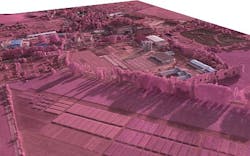Raytheon joins DARPA program to develop new kinds of 3D electro-optical imaging sensors
ARLINGTON, Va., 25 Sept. 2013.Electro-optics experts at the Raytheon Co. Space and Airborne Systems segment in El Segundo, Calif., will help U.S. military researchers develop fundamentally new avionics and vetronics electro-optic sensors for target identification and tracking under terms of a $19.4 million contract announced last week.
Raytheon will do the work as part of the second phase of the Military Imaging and Surveillance Technology - Long Range (MIST-LR) program, sponsored by the U.S. Defense Advanced Research Projects Agency (DARPA) in Arlington, Va.
The MIST-LR program of the DARPA Strategic Technology Office focuses on long-range geometric and 3-D imaging technology for characterizing targets beyond the physical-aperture diffraction-limit of the receiver system. The program focuses on new sensor methods involving computational imaging, synthetic-aperture imaging, digital holography, multi-static laser radar, and angle-resolved imaging based on light transport analysis.
Raytheon joins Trex Enterprises Corp. in San Diego on the MIST-LR program, which won a $23.6 million DARPA contract earlier this month for the MIST-LR phase-two program. Two contractors have been chosen for the program thus far, and more may be added later.
Optical sensors available today can help identify targets, but their sizes and operational ranges can be limiting, DARPA officials say. The MIST-LR program seeks to develop new sensing methods that address physical aperture of the imaging receiver, the effects of atmospheric turbulence, performance of the receiver array, the power of the illumination source, and the image formation algorithms are the primary defining characteristics of active imaging systems.
Technical areas of emphasis in the program are image resolution-2D and 3D; system link-budget and image signal-to-noise ratio; image quality, contrast, and the ability for automated identification; maximum relative target motion; image acquisition and processing time; image field of regard and range depth; image size and coverage rate; image frame rate; transceiver targeting and steering; target recognition; differential scene motion for detection; system size, weight, and power requirements; compensation of turbulence effects; and manufacturability and affordability.
For more information contact Raytheon Space and Airborne Systems online at www.raytheon.com, Trex Enterprises at www.trexenterprises.com, or DARPA at www.darpa.mil.
